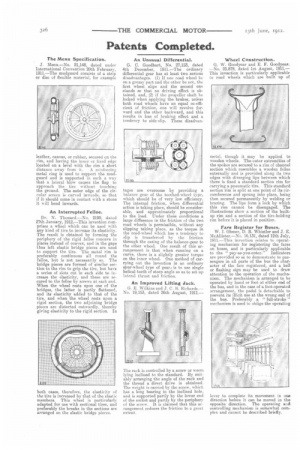Patents Completed.
Page 24

If you've noticed an error in this article please click here to report it so we can fix it.
The Menu Specification.
J. Menu.—No. 21,1413, dated under International Convention 20th February, 1911.—The mudguard consists of a strip or disc of flexible material, for example
leather, canvas, or rubber, secured un the .im, and having the inner or fixed edge ocated on a level with the rim a short distance away from it. A reinforcing metal ring is used to support the mudguard and is supported in such a way that a lateral blow causes the flap to approach the tire without touching the ground. The outer edge of the circular screen is curved inwards, so that if it should come in contact with a stone it will bend inwards.
An Interrupted Felloe.
Dr. N. Thonard.—No. 2199, dated 27th January, 1912.—This invention comprises a wheel which can be used with any kind of tire to increase its elasticity. The result is obtained by forming the periphery of the rigid felloe concave in places instead of convex, and in the gaps thus left elastic bridge pieces are used to support the tire. The metal rim is preferably continuous all round the felloe, hut is not necessarily so. The bridge pieces are formed of similar section to the rim to grip the tire, but have a series of slots cut in each side to increase the elasticity, and these are secured to the felloe by screws at each end. When the wheel rests upon one of the bridges, the latter is partly flattened, and its elasticity added to that of the tire, and when the wheel rests upon a rigid section, the two adjoining bridge pieces are distorted outwardly, thereby giving elasticity to the rigid section. In
both cases, therefore, the elasticity of the tire is increased by that of the elastic members. This wheel is particularly adapted for use with sectional tires, and preferably the breaks in the sections are arranged on the elastic bridge pieces.
An Unusual Differential.
G. C. Goodhart, No. 27,123, dated 4th December, 1911.—The ordinary differential gear has at least two serious disadvantages. (1) II one road wheel be on a greasy part and the other be not, the first wheel slips and the second one stands so that no driving effect is obtained, and, .(2) if the propeller shaft be locked when applying the brakes, unless both road wheels have an equal co-efficient of friction, one will revolve forward and the other backward, and this results in loss of braking effect and a tendency to side-slip. These disadvan tages are overcome by providing a balance gear of the toothed-wheel type, which should be of very low efficiency. The internal friction, when differential action is taking place, should be considerable, and approximately proportional to the load. Under these conditions a large difference in the friction of the two road wheels is permissible, without any slipping taking place, as the torque in the road-wheel which has a tendency to slip is transferred by the friction through the casing of the balance-gear to the other wheel. One result of this arrangement is that when running on a curve, there is a slightly greater torque on the inner wheel. One method of carrying out the invention in an ordinary spur-wheel type of gear: is to use single helical teeth of steep angle so as to set up lateral thrust and friction.
An Improved Lifting Jack.
G. E. Wilkins and J. C. B. Richards.— No. 19,153, dated 26th August, 1911.—
The rack is controlled by a screw or worm lying inclined to the standard. By suitably arranging the angle of the rack and the thread a direct drive is obtained. The weight is carried by the screw, which has a long bearing in the inclined hole, and is supported partly by the lower end of the socket and partly by the periphery of the screw. it is claimed that this arrangement reduces the friction to a great extent.
Wheel Construction.
G. W. Goodyear and E. F. Goodyear. —No. 23,978, dated 1st August, 1911.— This invention is particularly applicable to road wheels which are built up of metal, though it may be applied to wooden wheels. The outer extremities of the spokes are secured to a rim of channel section which resembles a wooden feIlee externally and is provided along its two edges with diverging lips between which there is fixed a standard section rim for carrying a pneumatic tire. This standard section rim is split at one point of its circumference and sprung into place, being then secured permanently by welding or brazing. The lips form a lock by which this rim cannot be disengaged. The illustrations show a section of the builtup rim and a section of the tire-holding rim before it is placed in position.
Fare Register for Buses.
W. I. Ohmer, D. B. Whistler and J_ E. McAllister.—No. 16,131, dated 12th July, 1911.—This invention relates to operating mechanism for registering the fares on buses, and is particularly applicable to the " pay-as-you-enter." Indicators are provided so as to demonstrate to passengers in all parts of the bus the character of the fare registered, and a hell or flashing sign may be used to draw attention to the operation of the mechanism. The mechanism is arranged to be operated by hand or foot at either end of the bus, and in the case of a foot-operated arrangement, the pedal is detachable to prevent its illicit use at the wrong end of the bus. Preferably a " full-stroke " mechanism is used to oblige the operating
lever to complete its movement in one direction before it can be moved in the opposite direction. The operating and controlling mechanism is somewhat complex and cannot be described briefly.
























